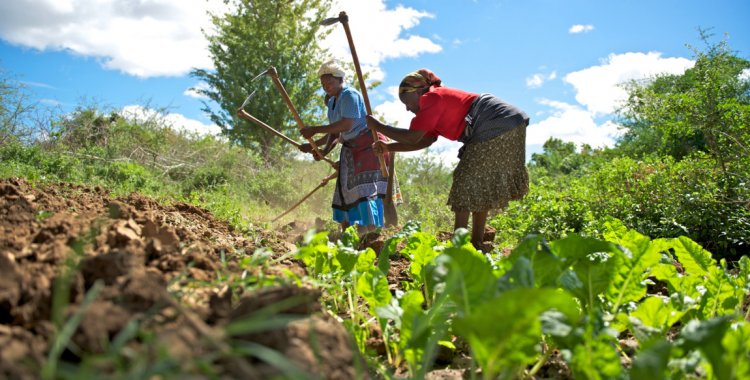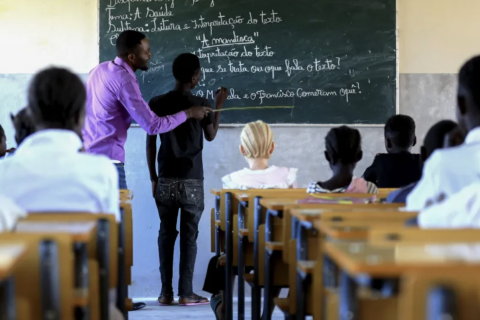ECA Twepwila, founded in 2021 and supported by the Strengthening Resilience and Food and Nutrition Security program in Angola (FRESAN), is one of them.
There work 25 women from the village of Tchiango, there they learn how to mitigate hunger, using unsophisticated and easy-to-apply agricultural techniques that allow them to improve food production.
From the choice of seeds, to the type of product and the way in which it is grown, enrichment of the soil with natural fertilizers, pest control with homemade insecticides made with a "mix" of local plants, there are several techniques that are taught in this school, where peasants also learn what not to do, avoiding, for example, uncontrolled fires.
In this Mumuíla community, which lives about 30 kilometers from Lubango, capital of Huíla province, around 50 people, mainly women and children, gathered today to welcome visitors with traditional songs and dances.
This is a delegation of representatives from international agencies and the European Union, members of the Government, civil society organizations and journalists, who will show how ECA can contribute to improving their lives.
In the two hectares where they learn and cultivate, the "students" sowed maize, massango and massambala (local cereals), onions, cabbage, beans, cabbage and other vegetables, using agricultural techniques that will allow them, if all goes well, to have food throughout the year, no longer depending only on cattle, the main source of wealth in this region.
Accompanying them is "professor" Eduardo Álvaro, an agroforestry specialist who develops the ECA's practical training methodology, in which peasants learn by doing, supported by facilitators from the community itself.
Teaching agriculture to farmers makes sense, guarantees the expert, stressing that "planning", according to the agricultural calendar, is a "key" to successful production.
ECA helps to clarify doubts in the fight against diseases and pests, teaches land preparation techniques and to plant according to the compass (distance between plants and between rows), introduces improved seeds and tubers resistant to drought such as cassava, for example.
"Farmers need coordination to increase their production, respecting the agricultural calendar", points out Eduardo Álvaro, adding that at the ECA it is even possible to generate some surplus to sell.
Maria Luísa, 61 years old and with eight children, is one of the students, and told Lusa how she learned to diversify the crops she sows, introducing cassava and sweet potato, which despite being very common in Angola, are not traditionally part of the of the diet of these populations.
She also claims that she learned to eat differently, but when asked what makes up her usual meals, she almost always cites the same products: "londi" (local plant), funge (flour and water porridge) and bean.
Maria Muapeletchi Limala, 21, is one of the EÇA facilitators and teaches how to use compasses and how to select seeds, and learned how to make controlled fires.
For now, she will continue to dedicate herself to farming and livestock, but says that hunger remains a reality.
"There is still hunger, life is hard, the rains are very difficult", laments the young woman, stating that many of the peasants are unable to produce.
In addition to hunger, thirst is another cause of vulnerability in these rural communities.
In the Malambi I village, in the Bata-Bata commune, land where there is no planting, there is no water and food is scarce, there are people who have found a way to quench their thirst in the cisterns-pavement.
The technology is simple to implement and the communities themselves build and manage these pyramid-shaped infrastructures. They are based on cement sidewalks that collect rainwater and send it to reservoirs with a capacity of 52,000 liters of water, where the water is stored and renewed to ensure the supply of families in the driest season.
Maria Vina Catchoca, one of the beneficiaries of this project and who is part of the cisterns management committee, says that she used to have to travel long distances to fetch water.
"You leave home at 7 am and return at 12 pm with a 20-liter plug on your head and another five liters in your hand so you don't have to repeat the trip several times", describes the 59-year-old woman and mother of seven.
"Before we had these tanks, we had two problems: hunger and thirst, we didn't have food and we didn't have water. The water issue is resolved, but I would be lying if I said that we are not hungry. It's from someone who doesn't eat well. We're still hungry, but we have to be grateful that, at least, we don't have to walk many kilometers anymore", Maria Vina accepts, with the harshness of life marked by thinness and aged skin.
Fighting hunger and thirst are the primary objectives of FRESAN, a program of the Angolan Government financed by the European Union, which is being implemented by Camões – Institute for Cooperation and Language, United Nations Food and Agriculture Organization (FAO) , United Nations Development Program (UNDP) and the Spanish hospital Vall d'Hebron.
The program, which has an allocation of 65 million euros, of which more than 48 million are managed by Camões, is entering its second year of implementation, and will run until August 2024, with several Angolan and international partners, including civil society organizations and Angola's central and local government departments.
Camões subsidizes 19 projects oriented towards family farming and access to water and nutrition, through field schools, rehabilitation of water points and construction of cisterns and community awareness in the context of malnutrition, among other initiatives.
In total, 139 ECAs have already been implemented (the target is 300), covering 8000 farmers, water infrastructure for human consumption that benefits 20,000 households, totaling 100,000 people, and 50 hectares irrigated with drip irrigation systems, with various types of production spread over three provinces in southern Angola: Huíla, Cunene and Namibe.







